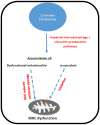Secondary Mitochondrial Dysfunction as a Cause of Neurodegenerative Dysfunction in Lysosomal Storage Diseases and an Overview of Potential Therapies
- PMID: 36142486
- PMCID: PMC9503973
- DOI: 10.3390/ijms231810573
Secondary Mitochondrial Dysfunction as a Cause of Neurodegenerative Dysfunction in Lysosomal Storage Diseases and an Overview of Potential Therapies
Abstract
Mitochondrial dysfunction has been recognised a major contributory factor to the pathophysiology of a number of lysosomal storage disorders (LSDs). The cause of mitochondrial dysfunction in LSDs is as yet uncertain, but appears to be triggered by a number of different factors, although oxidative stress and impaired mitophagy appear to be common inhibitory mechanisms shared amongst this group of disorders, including Gaucher's disease, Niemann-Pick disease, type C, and mucopolysaccharidosis. Many LSDs resulting from defects in lysosomal hydrolase activity show neurodegeneration, which remains challenging to treat. Currently available curative therapies are not sufficient to meet patients' needs. In view of the documented evidence of mitochondrial dysfunction in the neurodegeneration of LSDs, along with the reciprocal interaction between the mitochondrion and the lysosome, novel therapeutic strategies that target the impairment in both of these organelles could be considered in the clinical management of the long-term neurodegenerative complications of these diseases. The purpose of this review is to outline the putative mechanisms that may be responsible for the reported mitochondrial dysfunction in LSDs and to discuss the new potential therapeutic developments.
Keywords: Gaucher disease; Niemann–Pick disease; lysosomal storage diseases; mucopolysaccharidosis; neurodegeneration; secondary mitochondrial dysfunction; type C.
Conflict of interest statement
The authors declare no conflict of interest.
Figures
References
-
- Fuller M., Meikle P.J., Hopwood J.J. Epidemiology of Lysosomal Storage Diseases: An Overview. Oxford PharmaGenesis; Oxford, UK: 2006. Chapter 2. - PubMed
Publication types
MeSH terms
Substances
LinkOut - more resources
Full Text Sources
Medical



